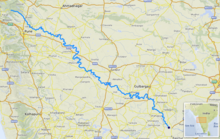
Back نهر بهيما Arabic نهر بهيما ARZ بهیما چایی AZB ভীমা নদী Bengali/Bangla Bhima Catalan Bhíma (řeka) Czech Bhima (Fluss) German Río Bhima Spanish Bhima (rivière) French भीमा नदी Hindi
| Bhima River Chandrabhaga River | |
|---|---|
 Bhima at Pandharpur | |
 Bhima river course [1] | |
| Location | |
| Country | India |
| State | Maharashtra, Karnataka, Telangana |
| Physical characteristics | |
| Source | Bhimashankar |
| • location | Maharashtra, India |
| • coordinates | 19°4′19″N 73°32′9″E / 19.07194°N 73.53583°E |
| • elevation | 945 m (3,100 ft) |
| Mouth | Krishna River |
• location | between Karnataka and Telangana about 24 km north of Raichur , India |
• coordinates | 16°24′36″N 77°17′6″E / 16.41000°N 77.28500°E |
• elevation | 336 m (1,102 ft) |
| Length | 861 km (535 mi) |
| Basin size | 70,614 km2 (27,264 sq mi) |
| Discharge | |
| • location | mouth |
| Basin features | |
| Tributaries | |
| • left | Ghod, Sina, Kagini |
| • right | Bhama, Indrayani, Mula-Mutha, Nira |
The Bhima River (also known as Chandrabhaga River) is a major river in Western India and South India. It flows southeast for 861 kilometres (535 mi) through Maharashtra, Karnataka, and Telangana states, before joining the Krishna River. After the first sixty-five kilometers in a narrow valley through rugged terrain,[1] the banks open up and form a fertile agricultural area which is densely populated.[2]
The river is prone to drying up during the summer season.[clarification needed] In 2005 there was severe flooding in Solapur, Vijayapura and Kalburgi districts. The river is also referred to as Chandrabhaga River, especially at Pandharpur, as it resembles the shape of the Moon.
- ^ Khan, Mirza Mehdy (1909). "Rivers". Hyderabad State. Imperial Gazetteer of India, Provincial Series. Calcutta: Superintendent of Government Printing. pp. 97–98. OCLC 65200528.
- ^ "Bhima River". Britannica Concise article. Archived from the original on 2 January 2013. Retrieved 11 December 2006.